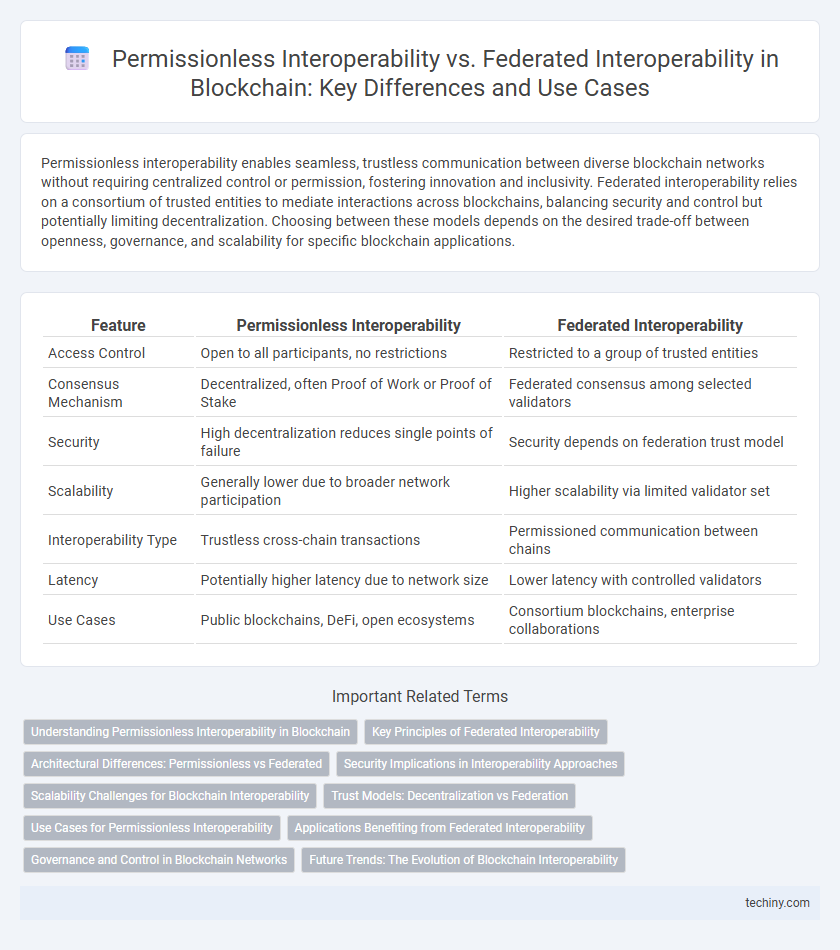Permissionless interoperability enables seamless, trustless communication between diverse blockchain networks without requiring centralized control or permission, fostering innovation and inclusivity. Federated interoperability relies on a consortium of trusted entities to mediate interactions across blockchains, balancing security and control but potentially limiting decentralization. Choosing between these models depends on the desired trade-off between openness, governance, and scalability for specific blockchain applications.
Table of Comparison
| Feature | Permissionless Interoperability | Federated Interoperability |
|---|---|---|
| Access Control | Open to all participants, no restrictions | Restricted to a group of trusted entities |
| Consensus Mechanism | Decentralized, often Proof of Work or Proof of Stake | Federated consensus among selected validators |
| Security | High decentralization reduces single points of failure | Security depends on federation trust model |
| Scalability | Generally lower due to broader network participation | Higher scalability via limited validator set |
| Interoperability Type | Trustless cross-chain transactions | Permissioned communication between chains |
| Latency | Potentially higher latency due to network size | Lower latency with controlled validators |
| Use Cases | Public blockchains, DeFi, open ecosystems | Consortium blockchains, enterprise collaborations |
Understanding Permissionless Interoperability in Blockchain
Permissionless interoperability in blockchain enables decentralized networks to seamlessly exchange data and assets without relying on a central authority, ensuring trustless and censorship-resistant interactions. This approach leverages open protocols and cryptographic proofs to facilitate secure cross-chain communication, enhancing liquidity and composability across public blockchains. By contrast, federated interoperability depends on a consortium of validators, limiting participation and introducing centralized points of control, which can hinder scalability and transparency.
Key Principles of Federated Interoperability
Federated interoperability in blockchain relies on a consortium of trusted entities that govern access and transaction validation, ensuring controlled data sharing across networks. Key principles include decentralized control among authorized participants, standardized communication protocols for seamless integration, and robust consensus mechanisms to maintain security and trust. This approach balances privacy and efficiency by limiting access to verified members while enabling cross-chain functionality.
Architectural Differences: Permissionless vs Federated
Permissionless interoperability enables blockchain networks to connect and exchange data without centralized control, leveraging open protocols and consensus mechanisms to maintain trust and security. Federated interoperability relies on a consortium of pre-selected validators that facilitate cross-chain communication through permissioned access, balancing control and collaboration among known entities. Architectural differences center on decentralization levels, where permissionless systems emphasize open participation, and federated models prioritize controlled governance.
Security Implications in Interoperability Approaches
Permissionless interoperability enables seamless data exchange across decentralized networks without centralized control, exposing systems to heightened security risks like unauthorized access and data breaches due to open participation. Federated interoperability restricts communication to a consortium of verified nodes, enhancing security through controlled access and consensus but potentially introducing trust dependencies and limited fault tolerance. Evaluating security implications requires balancing the openness of permissionless models with the governance and risk management inherent in federated approaches.
Scalability Challenges for Blockchain Interoperability
Permissionless interoperability in blockchain enables scalable, decentralized networks where any participant can join without restrictions, but faces scalability challenges due to intense consensus requirements and increased network traffic. Federated interoperability relies on a limited set of trusted validators, which can improve scalability by reducing consensus complexity, but at the cost of decreased decentralization and increased risk of central points of failure. Addressing scalability challenges in both models involves optimizing cross-chain communication protocols and deploying layer-2 solutions to handle growing transaction volumes efficiently.
Trust Models: Decentralization vs Federation
Permissionless interoperability operates on a decentralized trust model where no single entity controls the network, enabling open participation and censorship resistance. In contrast, federated interoperability relies on a federation of trusted nodes or organizations that govern the network, creating a semi-centralized trust environment. Decentralization enhances transparency and security through consensus mechanisms like Proof of Work or Proof of Stake, while federation offers efficiency and controlled access by limiting trust to known participants.
Use Cases for Permissionless Interoperability
Permissionless interoperability enables decentralized applications to seamlessly interact across multiple blockchain networks without centralized control, enhancing transparency and security in DeFi and NFT marketplaces. Use cases include cross-chain asset transfers, decentralized identity verification, and multi-chain smart contract execution, which promote user autonomy and eliminate single points of failure. This approach supports open ecosystems where developers and users benefit from increased liquidity, composability, and innovation across diverse platforms.
Applications Benefiting from Federated Interoperability
Federated interoperability enables secure data exchange and collaboration between select blockchain networks, making it ideal for enterprise applications requiring controlled access and compliance. Industries such as healthcare, finance, and supply chain management benefit from federated models by maintaining privacy while leveraging cross-network functionalities. This approach supports efficient sharing of sensitive information without exposing entire ledgers, enhancing trust and operational efficiency.
Governance and Control in Blockchain Networks
Permissionless interoperability enables seamless interaction across decentralized blockchain networks without centralized control, fostering open governance and user autonomy. Federated interoperability relies on a consortium of trusted entities to manage connectivity and decision-making, ensuring controlled access and compliance within governed frameworks. Governance in permissionless systems prioritizes community consensus, whereas federated models emphasize coordinated oversight by designated participants.
Future Trends: The Evolution of Blockchain Interoperability
Permissionless interoperability enables diverse blockchain networks to communicate without centralized control, fostering decentralization and broader asset transfer. Federated interoperability operates through a consortium of trusted nodes, balancing control with efficiency and streamlined consensus mechanisms. Future trends indicate a hybrid approach combining permissionless openness with federated security, driven by advancements in cross-chain protocols and layer 2 solutions enhancing scalability and seamless data exchange.
Permissionless Interoperability vs Federated Interoperability Infographic

 techiny.com
techiny.com